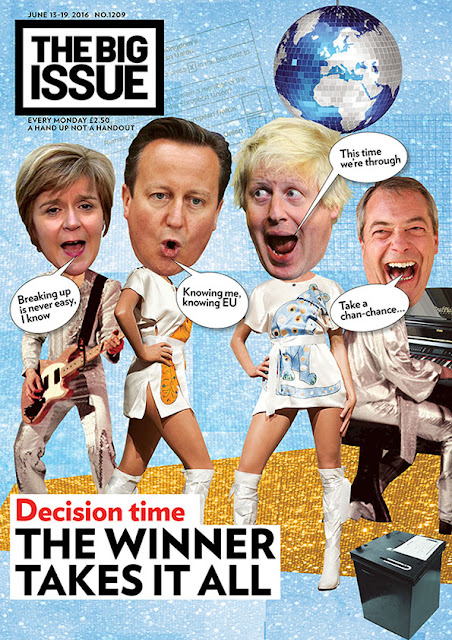Analyse why The Big Issue magazine has used an intertextual approach to the referendum on its front cover.

Analyse why The Big Issue magazine has used an intertextual approach to the referendum on its front cover.
How does intertextuality create meaning in this source?
Use of Abba reference (Swedish pop group)
Use of Personality (Nicola Sturgeon, David Cameron, Boris Johnson and Nigel Farage.)
Use of images
Use of text
Make judgements and reach a conclusion about the advantages of this use of intertextuality to The Big Issue magazine.
The Big Issue has references the EU referendum in there that
happened on 23rd June 2016 in their June 13-19 2016 edition. The cover has
intertextualised the Swedish pop group ABBA, to create a comedic effect on the
EU referendum. The Swedish pop group became one of the most commercially
successful acts in the history of popular music, topping the charts worldwide
from 1974 to 1982.
Within the cover, Nicola Sturgeon (Scottish National Party -
Remain), David Cameron (Prime Minister - Remain), Boris Johnson (Leave), and
Nigel Farage (UKIP - Leave), have been made to look like they are the band
members of the pop group. Prime Minister, David Cameron and UKIP Leader, Nigel
Farage, are made out to be the female lead vocalists. This portrays the leaders
as feminine, who are stereotypically weaker than men. This suggests that their
arguments to stay in/out of the EU are weak. Contrasting, Nicola Sturgeons head
is placed on the male guitarists body. This suggests that she has the role of a
male in parliament, and is therefore less feminine. Despite this, the roles of
Sturgeon and Farage in the campaign aren’t as important, so this is why they
appear to be positioned more in the background of the image as their faces aren’t
as recognisable to the campaign as Cameron and Johnson. In addition to this, each PM’s head is made to
look larger. This contributes to the comedic effect, as they appear to be on
the bodies of the pop group so are unlikely to be taken seriously. The facial expressions
on the images chosen of the MP’s all appear to have unserious facial
expressions. Mocking the MP’s, suggesting that they aren’t doing a very job at
leading their campaign. The outfits on
the bodies are in the 70's disco style which could be suggesting that as
parliament have been talking about leaving the EU for so long, the discussion
is old news so therefore humorous and isn't taken seriously.
Closely linking to the disco theme, there is a disco ball
within the top right hand corner of the cover, however it is a globe of the
world, rather than a silver sparkling glitter ball. The UK is on the centre of
the globe, showing perspective of the size of the country compared to the rest
of the world. This suggests that the decision is minor, and that the outcome is
clear, even though the decision will have a large effect on the country. Also
within the background, there is images blended into the sparkling blue of the
ballot paper, and in the bottom right hand corner, and image of a ballot box.
The use of text is also intertextualised with the ABBA
theme. The main headline states ' The winner takes it all' which is a song
title of one of ABBA's most famous tracks. This relates to the campaign as the
side that wins the referendum takes the position in or out of the EU that they
were hoping for. The colours chosen also link with the colours used on the
masthead. This makes both the texts stand out from the blue background, and
also make the cover appear be brought together as the colour scheme links. Not
only this, but within the speech bubbles out of the MP's mouths, are song
lyrics to ABBA records, which also relate to the campaign, such as the pun in
the speech bubble from Cameron mouth, 'knowing me knowing EU' which is a clever
play on words, linking the song lyrics to the referendum. Within Farage’s speech
bubble ‘states the song title ‘Take a Chance’ which suggest that Farage’s
argument isn’t strong as he is taking a chance with his campaign suggesting that
it is unknown what is to occur if he leads the UK to leave the EU. Sturgeon’s speech
bubble states the ABBA lyric ‘Breaking up is never easy, I know’ This is personal
towards the MP as its n first person ‘I’ suggesting that she has experience some
difficult breakups in her personal life. This connects to her gender as a
female she is stereotypes to make it seem like it is hard to break up from a
relationship, suggesting her dependency on a man, whilst the message also
conveying that if the UK is to exit the EU than it would be a difficult process.
Advantages of the use of intertextuality to the Big Issue
magazine is that it stands out from other magazines or articles that are
covering the referendum. This is because some members are portrayed as the opposite
sex which creates a comedic effect which amuses the audience, creating a light
hearted effect out of the campaign. The use of choosing the popular Swedish
band, ABBA, makes the magazine stand out as the 70’s style and song lyrics are
recognised by a wide audience and will interest those who also take less interest
in reading about the referendum or political stories.
Comments
Post a Comment